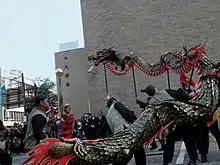Nagasaki Kunchi
Kunchi (くんち), also Nagasaki Kunchi (長崎くんち) or Nagasaki Okunchi (長崎おくんち), is the most famous festival in Nagasaki, Japan.[1] It began as a celebration of autumn harvests in the late 16th century and became a shrine festival when Suwa Shrine was founded in 1614. The name kunchi is derived from the word kunichi (九日, the ninth day of the ninth lunar month of the year).[1] The festival originally began on the seventh day of the month and lasted through the ninth day, maintained today as Okunchi's start date of October 7th and end date of October 9th.

According to local explanation, another purpose was to check for hidden Christians after the ban on Christianity.[2] This is still evident today in the custom of garden showing (庭見せ, niwamise), when the presenting neighbourhoods open up their homes to public scrutiny. One of the most famous performances of the festival is the Dragon Dance which was originally performed on New Year's Eve by the Chinese residents of Nagasaki. Rehearsals for the festival begin on June 1. From October 7–9 the presentations of the festival, which vividly reflect Nagasaki's colourful history, spill over from the three festival sites into the streets and create an atmosphere of celebration throughout the city.
Performances
Nagasaki Kunchi includes a number of folk performing arts, including jaodori (龍踊り, dragon dance), kujira no shiofuki (鯨の潮吹き, the blowing of the whale), kokkodesho (コッコデショ, drum dance), and Oranda manzai (阿蘭陀万才, Dutch dance).[2]
See also
References
- Hesselink, Reinier H. (2004). "The Two Faces of Nagasaki: The World of the Suwa Festival Screen". Monumenta Nipponica. 59 (2): 179–222. ISSN 0027-0741.
- Lancashire, Terence A. (2016-04-15). An Introduction to Japanese Folk Performing Arts. Routledge. p. 185. ISBN 978-1-317-18169-9.
External links
- (in Japanese) Nagasaki Dento Geino Shinko-kai
- (in Japanese) Nagasaki Kunchi, Nagasaki Shimbun